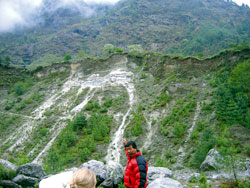|
|
| WASHED AWAY: Norbu Sherpa points to the spot where his house once stood before it was destroyed by the Dig Tsho flood in 1985. |
Just over 20 years ago I saw a glacial lake outburst flood destroy my home. This summer I saw a forest fire. In between we've seen numerous other changes, incremental rather than dramatic-less winter rain, fewer mushrooms in the forest, the snow line moving up-that we now know are the result of climate change.
When Langmoche glacier, also known as the Dig Tsho glacial lake, broke its banks at 3PM on 4 August, 1985, in just two hours our little village was shattered. We lost houses, cattle, and arable land. The damage amounted to Rs 1.2 million back then. Also destroyed were the almost-completed microhydropower plant in Thamo, which cost $1.5 million and hundreds of hours of lobbying, planning, and work. Bridges were damaged and communications cut off.
After two decades of hard work, we've bounced back. One of my jobs is working as a tourist guide in season. When I was a child, we'd get two to three feet of snow in the village, and it would stay for days. Now I count myself lucky that I can see something like that when I go trekking and climbing in the high mountains.
Winter rain, so important for agriculture and our water supply, has become also become unpredictable. The dry winter we had last year is what caused the forest fire, something we've never seen. The forest behind our village is drying up. The spring the village uses for drinking water and irrigation is also drying up, and the water mill between Ghat and Phakding is no longer functional.
Talk to elders who know about these things and they'll tell you how sensitive mushrooms, which we love, are to changes in climate, and how the forests behind Ghat were once filled with bamboo shoots and mushrooms.
It's incredible what a ripple effect something like climate change can have. You wouldn't think builders would be terribly affected, but of course they are. Tenzing, a construction expert in Ghat says traditional knowledge about how to build houses is dying out. "Now homes have thinner walls and the roofs need a lot less support. It just isn't as cold as it used to be, nor does it snow as much, so we're forgoing traditional insulation and construction techniques and materials."
Every time I go trekking I'm awed by the beauty of where I come from. But I also see the snow line moving up, and glacial lakes forming and expanding. Many of the factors behind climate change may be far away, in North America and Europe, but we feel the impact here. Every time I see a glacial lake-and there are many-I get a bit of a jolt, and wonder what if.
While the prospect of another GLOF is terrifying, I, and many like me, worry about the small signs even more. A fern disappears, a forest dries up and burns, pastures move further up and homes down to the cities. And we lose a part of what makes us who we are.
Norbu Sherpa, a high altitude trekking and climbing guide, is also former chairman of the Dudh Kunda community forestry user group in Sagarmatha National Park's buffer zone.



